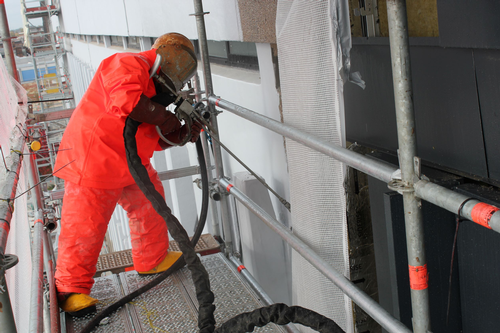WEDNESDAY, NOVEMBER 16, 2022
Waterjetting contractor Sabre Jetting Services has recently devised a method to remove render from concrete surfaces, while reducing water pressure to control costs and ensure project deadlines.
The surface preparation project, commissioned by construction and civil engineering specialist McLaughlin & Harvey, was carried out at Coventry University in England.
About the Project
Opened in 1967, the seven-story Graham Sutherland Tower hosts part of the university’s faculty of arts and humanities. The phased redevelopment and refurbishment work reportedly began in June of last year, following the demolition of the former Bugatti building to make way for the new development.
According to McLaughlin & Harvey, work consists of refurbishment and remodeling of the four-story Maurice Foss building and the construction of a new four-story teaching facility adjacent to the existing School of Art and Design accommodation.
Additionally, work includes refurbishment and remodeling of the existing art and design workshop, and full remodeling and refurbishment of the Graham Sutherland building. The new building will link the Graham Sutherland and Maurice Foss buildings.

 |
| Sabre Jetting, WJA |
|
Waterjetting contractor Sabre Jetting Services has recently devised a method to remove render from concrete surfaces, while reducing water pressure to control costs and ensure project deadlines. |
McLaughlin & Harvey, which will also reportedly provide high-quality studios and workshops for film, photography, printmaking, wood, metal, plastics, ceramic faber clay and digital education, contracted Sabre Jetting to carry out surface preparation work on the Graham Sutherland building refurbishment.
One priority for the project was preserving the tower’s large aluminum windows, which are being retained. Because they could have been damaged by the conventional technique of removing render from concrete, the waterjetting teams needed to rethink their approach.
Using waterjetting was the “ideal technique” to prepare the concrete surfaces for the paint finish required by the design plan. Using mechanical tools would have damaged the concrete, risked damaging the windows and taken more time.
“Surface preparation is usually carried out at pressures of at least 2,500 bar, which is 36,000 psi. But at that pressure, the windows were at greater risk of being damaged. This meant a team of operatives would have had to put in extensive protection measures, such as boarding and taping, before our teams could start work,” explained Managing Director David Malin.
“Instead, I thought perhaps we could try lowering the water pressure and increasing the flow rate. We did a series of trials and found a suitable technique that worked.”
According to the company’s release, Sabre Jetting found the ideal pressure and flow combination was water pressure at 1,150 bar (17,000 psi) which increasing the water flow rate from 25 to 45 L/min. Jetting operatives could reportedly remove the cementitious render, including a grit surface coating, without the windows needing substantial protection.
“It has turned out to be very effective. Technical know-how, a willingness to try something new, and the skill of our operatives has contributed to a good solution. The method of removing the render in this manner has substantially reduced costs for the client,” said Malin.
“It’s an example of how we try to think outside the box on behalf of our clients, whether that’s to improve safety, productivity, sustainability, or protect surfaces and control costs, which was the primary factor in this case.”
“This project is a very good example of the advantages of water jetting, and how WJA members add value in planning and delivering building maintenance and refurbishment work in the most effective and sustainable ways,” said John Jones, President of the Water Jetting Association.
Over the last nine months, Sabre Jetting reports that it had to overcome other challenges at it carried out work, requiring a significant amount of extra-long jetting hoses to be laid around the work area to ensure access around a complex site and to work at height.
A timelapse of McLaughlin & Harvey’s construction work can be found here.
Tagged categories: Colleges and Universities; concrete; Ongoing projects; Program/Project Management; Rehabilitation/Repair; Surface preparation; Surface Preparation; Surface preparation equipment; Tools & Equipment; Waterjetting